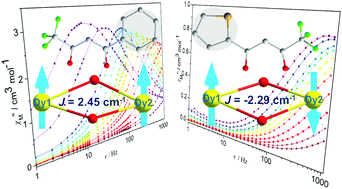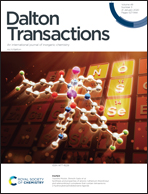Modulating magnetic dynamics through tailoring the terminal ligands in Dy2 single-molecule magnets†
Abstract
Complexation of dysprosium(III) ions with a multidentate hydrazone ligand, N-[(E)-pyridin-2-ylmethylideneamino]pyridine-2-carboxamide (L), in the presence of different β-diketonate coligands, leads to the formation of two novel DyIII dimers, with formulas Dy2(BTFA)4(L)2 (1) and Dy2(TTA)4(L)2 (2) (BTFA = 3-benzoyl-1,1,1-trifluoroacetone and TTA = 4,4,4-trifluoro-1-(2-thienyl)-1,3-butanedionate). They exhibit slightly different coordination geometries around DyIII centers and discrepant binuclear motifs – as a result of altering the β-diketonate coligands – which has an impact on the magnetic interactions between metal centers, the local tensor of anisotropy on each DyIII site and their relative orientations, therefore contributing to distinct magnetization dynamics. Compared to 2, complex 1 exhibits a more significant slow magnetic relaxation of SMM behavior in the absence of a dc field. The QTM effect is effectively repressed under a static field, resulting in the energy barriers of 57 K for 1 and 38 K for 2. Ab initio calculations clarify that, strong single-ion magnetic anisotropies exist in both complexes, whereas intermetallic ferromagnetic interaction and antiferromagnetic interaction are observed in 1 and 2, respectively, therefore resulting in dissimilar magnetization dynamics.



 Please wait while we load your content...
Please wait while we load your content...